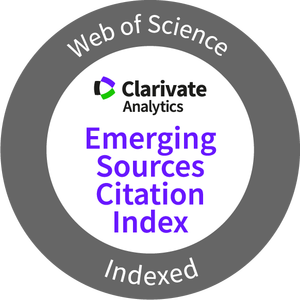Analysis of the performance of the portable Cortex Metamax 3B gas analysis system in simulated and real workouts with Vietnamese teenagers
Resumen
The aim of this study was to investigate the performance of the mobile Cortex Metamax 3B (MM3B) automated gas meter in simulated and real workouts involving teenagers. A total of 28 healthy volunteers (13 men, 15 female) were selected with the following characteristics (mean ± SD): age 17.2 ± 3.1; height 167.1 ± 13.5 cm; weight 54.6 ± 10.4 kg. The following equipment were used: Hypermax 3B (breath-by-breath breathing system), Validator for Gas Exchange Systems (VGES), and Douglas-bag technique (DBT). The results have shown that MM3B is stable at the permitted range during 3 hours while monitoring the gas fractions, as well as the VE, VO2, and VCO2 created by GESV, especially at moderate and high metabolic rates (2% deviation and modest physiological significance). MM3B rated both VO2 and VCO2 significantly higher by about 10-17% at moderate and strenuous activity than DBM and at all exercise levels than Oxycon Pro, although without a significant margin of error in VE. Between the two criteria systems, none of the metabolic variables showed any discernible change (DBM and Oxycon Pro). The MM3B provided acceptable data on stability and reliability, but it was decided that without further adjustment for VO2 and VCO2, the data were not valid during moderate and strenuous activity.
Descargas
Citas
Atkinson, G., Davison, R. C. R., & Nevill, A. M. (2005). Performance characteristics of gas analysis systems: what we know and what we need to know. International Journal of Sports Medicine, 26(1), 2-10.
Bland, J. M., & Altman, D. (1986). Statistical methods for assessing agreement between two methods of clinical measurement. The Lancet, 327(8476), 307-310.
Bradley, J. V. (1958). Complete counterbalancing of immediate sequential effects in a Latin square design. Journal of the American Statistical Association, 53(282), 525-528.
Daniels, J. (1971). Portable respiratory gas collection equipment. Journal of Applied Physiology, 31(1), 164-167.
Douglas, C. G. (1911). A method for determining the total respiratory exchange in man. Journal of Physiology, 42, 17-18.
Durnin, J. V. G. A., & Passmore, R. (1967). Energy, work and leisure. Heinemann Educational Bocks. Ltd.
Eriksson, S. J., Rosdahl, H., & Schantz, P. (2012). Validity of the Oxycon Mobile metabolic system under field measuring conditions. European Journal of Applied Physiology, 112, 345-355.
Foss, Ø., & Hallen, J. (2005). Validity and stability of a computerized metabolic system with mixing chamber. International Journal of Sports Medicine, 26(07), 569-575.
Gore, C. J., Catcheside, P. G., French, S. N., Bennett, J. M., & Laforgia, J. (1997). Automated VO2max calibrator for open-circuit indirect calorimetry systems. Medicine and Science in Sports and Exercise, 29(8), 1095-1103.
Huszczuk, A., Whipp, B. J., & Wasserman, K. (1990). A respiratory gas exchange simulator for routine calibration in metabolic studies. European Respiratory Journal, 3(4), 465-468.
Johnson, R. E., Robbins, F., Schilke, R., Mole, P., Harris, J., & Wakat, D. (1967). A versatile system for measuring oxygen consumption in man. Journal of Applied Physiology, 22(2), 377-379.
Kofrányi, E., & Michaelis, H. F. (1940). Ein tragbarer Apparat zur Bestimmung des Grasstoffwechsels. Arbeitsphysiologie, 11, 148-150.
Laurent, C. M., Meyers, M. C., Robinson, C. A., Strong, L. R., Chase, C., & Goodwin, B. (2008). Validity of the VmaxST portable metabolic measurement system. Journal of Sports Sciences, 26(7), 709-716.
Macfarlane, D. J. (2001). Automated metabolic gas analysis systems: a review. Sports medicine, 31, 841-861.
Medbø, J. I., Mamen, A., Welde, B., Heimburg, E. V., & Stokke, R. (2002). Examination of the Metamax I and II oxygen analysers during exercise studies in the laboratory. Scandinavian Journal of Clinical and Laboratory Investigation, 62(8), 585-598.
Meyer, T., Davison, R. C. R., & Kindermann, W. (2005). Ambulatory gas exchange measurements-current status and future options. International Journal of Sports Medicine, 26(1), 19-27.
Perkins, C. D., Pivarnik, J. M., & Green, M. R. (2004). Reliability and validity of the VmaxST portable metabolic analyzer. Journal of Physical Activity and Health, 1(4), 413-422.
Prieur, F. A. B. R. I. C. E., Castells, J., & Denis, C. H. R. I. S. T. I. A. N. (2003). A methodology to assess the accuracy of a portable metabolic system (VmaxST). Medicine and Science in Sports and Exercise, 35(5), 879-885.
Unnithan, V. B., Wilson, J., Buchanan, D., Timmons, J. A., & Paton, J. Y. (1994). Validation of the sensormedics (S2900Z) metabolic cart for pediatric exercise testing. Canadian Journal of Applied Physiology, 19(4), 472-479.
Vogler, A. J., Rice, A. J., & Gore, C. J. (2010). Validity and reliability of the Cortex MetaMax3B portable metabolic system. Journal of Sports Sciences, 28(7), 733-742.
Wasserman, K., Hansen, J., Sue, D., Casaburi, R., & Whipp, B. (1999). Principles of exercise testing and interpretation: including pathophysiology and clinical applications. Lippincott Williams & Wilkins.
Las obras que se publican en esta revista están sujetas a los siguientes términos:
1. El Servicio de Publicaciones de la Universidad de Murcia (la editorial) conserva los derechos patrimoniales (copyright) de las obras publicadas, y favorece y permite la reutilización de las mismas bajo la licencia de uso indicada en el punto 2.
© Servicio de Publicaciones, Universidad de Murcia, 2013
2. Las obras se publican en la edición electrónica de la revista bajo una licencia Creative Commons Reconocimiento-NoComercial-SinObraDerivada 3.0 España (texto legal). Se pueden copiar, usar, difundir, transmitir y exponer públicamente, siempre que: i) se cite la autoría y la fuente original de su publicación (revista, editorial y URL de la obra); ii) no se usen para fines comerciales; iii) se mencione la existencia y especificaciones de esta licencia de uso.
3. Condiciones de auto-archivo. Se permite y se anima a los autores a difundir electrónicamente las versiones pre-print (versión antes de ser evaluada) y/o post-print (versión evaluada y aceptada para su publicación) de sus obras antes de su publicación, ya que favorece su circulación y difusión más temprana y con ello un posible aumento en su citación y alcance entre la comunidad académica.




















